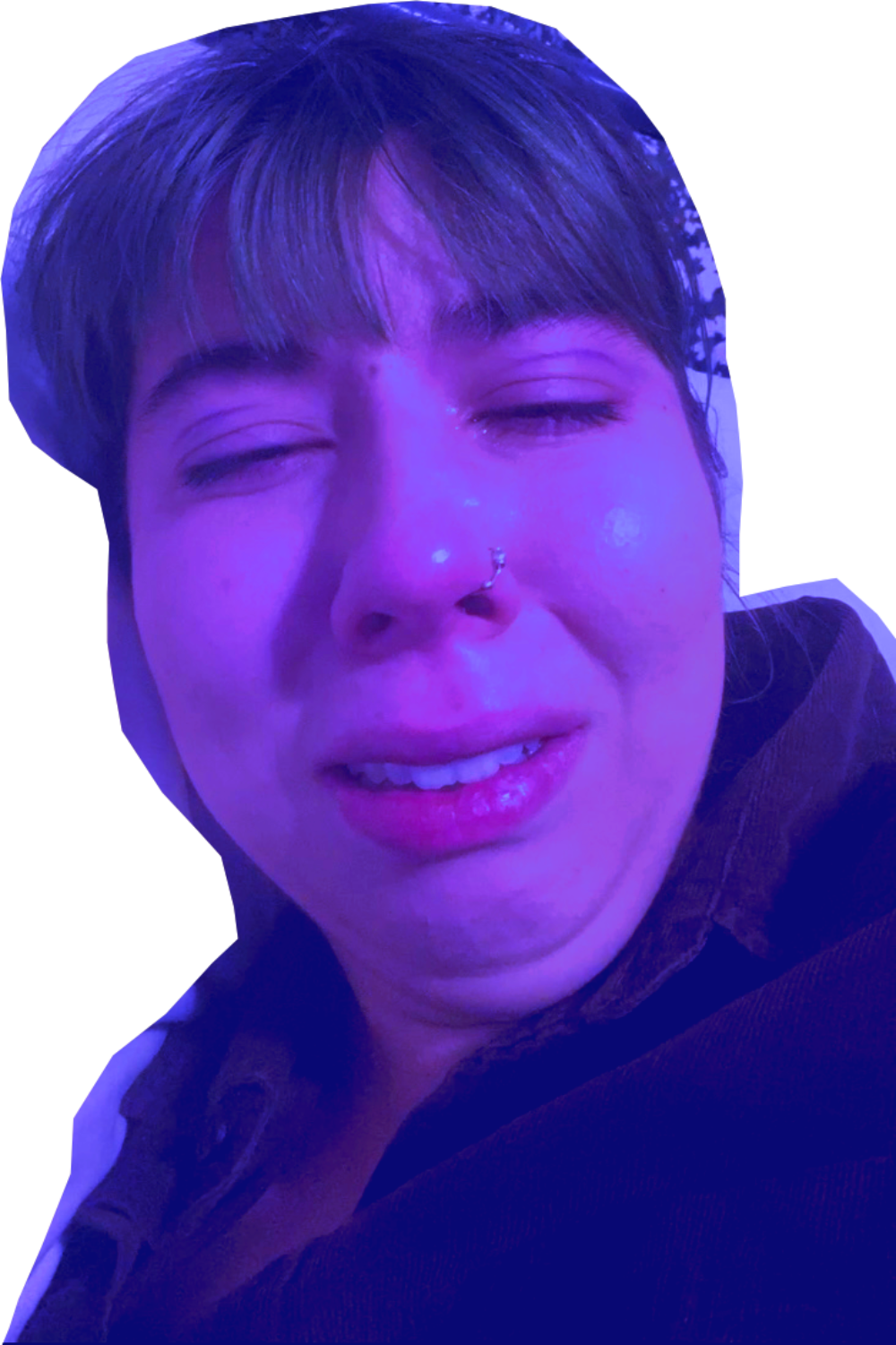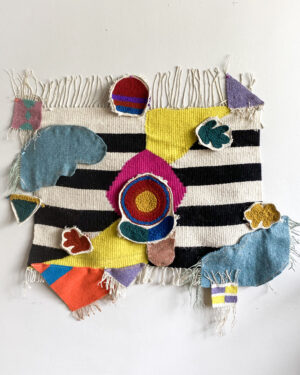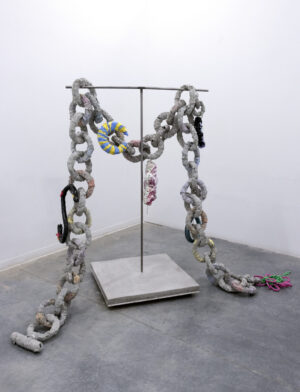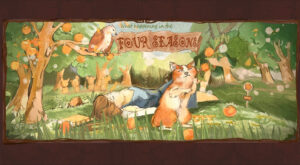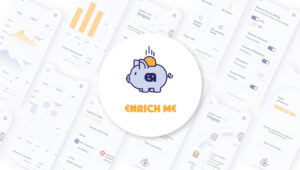smile
Stephanie Ford
See it On Campus: Level 2
Visitor Infoyou can find it beside the library. it's a lot cooler in person.
a critique on design’s relationship to capitalism aka a list of things i don’t like about design.
my name is stephanie and i’m a multidisciplinary artist. i grew up doing fine arts, painting mostly, that’s what got me into university. but over the last 4 years i have been working towards a communications design degree, and within the last year and a half i have really started to hate it. i never had any intention of being a designer, it was never on my radar, i had not even really grasped what a graphic designer was outside of making advertisements and logos. but i declared comd as my major because i wanted a better chance of getting a job after i graduated. i liked my program, it introduced me to print media, and publication design which i really like. we were always given very open ended briefs with full creative control. unfortunately, that is not what happens in the real world. i don’t want to spend my life completing other people’s briefs and limiting myself to what their project requires, or worse just running a company’s instagram account. i think a lot of people that choose design as a career path see that as a plus though, they want to make people’s visions come to life. which is cool but why is their vision always to sell shit. i don’t want to spend my life pushing consumerism down people’s throats. i just want to make art. that leads me to where i am right now, about to graduate and showing off my final university project. a project that is centered around everything i hate about design. this project is not positive or optimistic in any way, because that is what i needed. i needed to get this all out of my system. i have a better outlook on design now, but i have no intention of working in the corporate design world. i am looking forward to taking all of the knowledge i have learned here and creating things that bring me joy.
the internet
the constant bombardment of information at all times
the internet is a massive hub of information, which can be great and very helpful but our brains can only take in so much information at once. while we can certainly look at/watch/read a new piece of information every few seconds that doesn’t mean we can actually absorb and process all of it. i personally will find myself scrolling on an app like tiktok for hours watching probably 150-200* videos a day and i could only recount only a handful. i know it’s bad for me, i know it’s a time suck but it has created this reality, at least for me, that without it, without that constant stimulation, i become so mind numbingly bored. because it is so addictive. with the way that a lot of the internet, specifically social media, is set up everything is given the same level of importance. real news, fake news, your friends birthday brunch, an ad for shein- it’s all given the same amount of space* . so how are we, and especially the kids growing up with this, supposed to create those divides? it’s like one step forward, three steps back. because with how amazing it is that the internet has been able to give a voice to the previously voiceless, it has also kept a space for the original oppressors. and if i know anything about equality vs equity, the oppressors still win in this case *cough cough alt-right pipeline cough cough*.
*probably more but that’s kind of embarrassing
**maybe i’m wrong here, i think ads are given a higher standing because they outnumber any form of real content
unrealistic expectations/performative nature of social media
posting on social media as a creative is such a daunting task. i often find it so intimidating that i wont post things for weeks, maybe even months at a time. but unfortunately if you want the algorithm to work in your favour then you have to post constantly, it’s like a full time job. this is difficult for people who aren’t constantly making new content. so what is a person supposed to do when they are working on a longer term project, or are in a creative slump? well, they have to exploit it in whatever way they can. post behind the scenes, progress shots, tips on how to get out of a creative slump- even if you are currently in one and can’t get out. but keep in mind that whatever you post, has to be perfectly a perfectly crafted piece of media.
social media adds so much extra stress to the creative process because now it all has to be aesthetically pleasing. when i see other creatives post things like “it’s not all glitz and glamour” or “this is the stuff you don’t see” and then they proceed to share a perfectly curated mess, it feels so disingenuous. maybe it’s not, maybe they are just very neat and tidy, but i know that my process, my “behind the scenes mess” looks nothing like theirs. if i were to post my workspace while in the middle of a big project, it would not be met with the same positive reaction, i would probably end up on hoarders. it’s like fake relatable content- people pretend they can relate to it but are secretly jealous or ashamed that their set-up is in much worse a state.
also can we talk about how if you want to make any sort of content around your work you either have to do it during the day or have really expensive lighting! i can’t count how many times i have had the motivation to create but didn’t because the sun had already set so i couldn’t film it or take pictures. it’s really annoying, i am not a morning person. i am a night time gremlin that does my best work in the moonlight.
every corner of the internet is so oversaturated that it feels like a complete waste of time to post anything. it seems impossible to gain a following and i feel like i’m just posting into the void. but social media has become such an important tool for artists to use. every few months i find myself googling, “how to grow an instagram account” because the algorithm is constantly changing- and if you’re new, or small then it’s changing in the worst way for you. it’s constantly evolving to make more money, so it will boost its already established creators and suppress everyone else. with the boom of tiktok, video content is the only thing getting pushed on every platform. it has become this monster of a thing where now, if you want to create an audience for your work, not only do you have to be skilled at your craft but you also have to be a skilled photo/ videographer and set designer. you need good lighting, good backdrops, good editing software, and a slew of other things i’m sure. it’s overwhelming and exhausting and feels like a massive waste of time, but it also feels like there is no other choice.
the presence of social media in our lives has created a constant audience that we are constantly trying to please. shockingly, i think that can have a pretty negative impact on not only our psyche but also the creative process. now before beginning a project we have to think, how will this perform on social media? is it instagramable? will people like this enough to share it? for designers these things probably seem important to think about, given that communication is sort of our whole thing. but not everything has to communicate to everyone, our audience doesn’t always have to be the whole world. it’s ok to create if only for yourself.
working & operating under capitalism
professionalism
professionalism is rooted in racist, ableist and classist beliefs. it exists to uphold white supremacy. that’s all i have to say about it.
the exploitation of the working class
reading this you might think, oh wow, they must really hate designers, but that’s not the case. i don’t hate designers anymore than i hate bankers or grocery clerks. we are all trying to survive under capitalism however we can. so long as the job doesn’t infringe on other peoples rights, then i would never hate someone for having a job. what i hate is the system that all of these jobs live and operate under. and the reason why i am focusing so heavily on design here is because it’s what i do, but also, design directly serves capitalism. advertisements, branding all that stuff promotes mass consumerism. and not only that but it also does a really good job at covering up just how shity a lot of these companies actually are. design can create such a dense barrier from reality, which in turn allows for more exploitation to take place. but again, i don’t think that individual designers are at fault for this. if anyone is to blame it’s all the billionaires who use branding as a shield to further exploit their workers, and create such a competitive market for independently owned businesses forcing them to probably exploit their workers as well. capitalism benefits very few people and the rest of us are left to fend for ourselves and struggle, so do what you gotta do to survive. i just encourage you to think critically about what/ who you are designing for and who’s getting the short end of that stick.
side hustle culture must die
repeat after me: it is ok to just have a hobby.
it seems at every turn someone is turning their light hobby into a side hustle. does capitalism have such a tight grip on our balls that we can’t enjoy anything without somehow profiting from it? “time is money”- something that is constantly being drilled into our heads. believe it or not this isn’t actually true, time is just time and money is just money and both of them are just made up constructs. call it a radical idea but, we shouldn’t have to spend all of our time trying to earn enough money to survive. we should be able to survive for free. and we should be able to just enjoy our hobbies without the added stress of trying to be financially successful! i’m always picking up new crafting skills and the first response i usually get when i tell people about it is “oh wow, you could sell those”. it all sounds well and good at first, they say when you’re doing something you love you never work a day in your life. lies. when you’re doing something you love you’ll work every single day of your life. whatever you love is going to become 100% more stressful when you have to sell it, because the market is so oversaturated now it’s going to become like another full time job to actually get your stuff seen and bought. and on top of that you now have the added stress of public acceptance, and you now essentially have clients to think about when making whatever it is you love to make. it’s a lot harder to love your craft when you’re constantly making it to please other people. all if this on top of another (probably) full time job? talk about burnout.
now listen, i know some people have to do stuff like this in order to make ends meet, i get it, i respect it. my point is that it shouldn’t be necessary and people should be able to live comfortably without spending every waking moment trying to make more money. and we should allow ourselves to just enjoy things for what they are, and to try new things and to not be perfect at everything.
performative design
the performative aspect of design as a method of protest
let’s get one thing clear here, for decades graphic design as a tool has been used for very valid forms of protest. things like posters, zines and signs have acted as extremely useful ways to spread awareness and spark change. what i am talking about here is how it has shifted over the years with the influx of social media. an annually occurring example would be the month of june aka pride month. promptly on june 1st we see businesses change their logos, and put up posters with the rainbow flag and then just as quick, 12am on july 1st all the rainbows vanish. this would be less of a problem if they were actively supporting the queer community all year round, or even if they offered real support during the month of june. but showing the flag is usually where the support stops. which says, to me, that they don’t actually care it’s only for public appearances, because all the other companies are doing it, and not doing it will lose them the business of queer people*. another perfect example really stepped into the spotlight recently. did you post a black square on your instagram june 2 2020? share an infographic or two on your story? any follow up? the summer of 2020 really showed how people/brands will do the bare minimum to support a cause, so long as it’s trendy, while doing the least amount of effort and not making any actual change whatsoever. those easy to share infographics quickly lost a lot of impact when the information kept being watered down by making it fit into a cute and trendy aesthetic to the point where the design completely overpowered the message. it’s interesting to me that the venn diagram of people/brands who posted the bare minimum to support blm for like a month and the people/brands who actively do daily harm to marginalized communities, is basically a circle. graphic design isn’t going to be what saves the world, it is simply a tool used by those who will save it. and when used by those people it is very effective, when used by others all it does is bury the good stuff.
*because they think of queer people as trend setters.
nature of the field
the exploitation of design/art competitions
as a young artist i was often looking for ways to get my stuff out into the public, and one of the most common things i came across was art/design competitions. put on by some organization, band or company, there are specific guidelines to follow and a deadline. and once you submit that art it’s no longer yours, even if you don’t win. these competitions are framed in such a backwards way that prey on the naivety of young creatives. the pay off if you win is maybe a small sum of money and or exposure, none of which is really equivalent to the amount of work you put into it. and if you don’t win? well you get squat, occasionally there is a 2nd/3rd place runners up prize which again is not going to be equivalent to the work you put into it. these contests benefit only the people running them and do active harm to the artistic community. there is already such a struggle these days with getting people to value creative work and when competitions like this are held it only upholds this idea that creatives shouldn’t be paid for their labour. win or lose, all contestants in these competitions are being exploited because there is no guarantee of compensation and the compensation probably isn’t worth it. a lot of these are hosted by groups with a small creative budget, and they know that they can’t afford to hire a professional who knows their worth, so they prey on the inexperienced, young, emerging creatives. not only are they getting free labour, but they are also getting free exposure for their event- those contests that rely on you getting votes to win? that’s an ad. if you want to host an ethical and non exploitative competition to get a range of choices- don’t, but if you do every single contestant should be properly compensated.
gate keeping
gatekeeping is the activity of controlling, and usually limiting, general access to something. gatekeeping in design goes back to the idea that designers think they know best and anyone without the same level of education or equiptment can’t even attempt to design something good. i think this stems from the fact that design has become so democratized with things like fiverr and canva that “professional” designers are looking for anything they can grab onto to keep themselves on a “higher level” than everyone else. so perpetuating the idea that anything behind a paywall makes it better. like adobe being the industry standard, or needing to have a degree in design, or having to struggle through unpaid internships* the paywall there is that you are financially sound enough to be able to take an unpaid job. in a world where everyone is a designer, the industry keeps moving the goalpost to keep the pool of “good” designers small.
*the paywall there is that you are financially sound enough to be able to take an unpaid job
design isn’t neutral or universal
often designers think they know best, they know the best way to set type, they know the best way to display data, they know the best layout to use, they know the best way to communicate an idea. but they only know the best way that is relevant to their lived experience and with that comes their personal biases that may consciously or subconscious alter their work. all of that is fine so long as you are designing for that specific audience because once you try to broaden that, without relevant research and a proper test group, you are going to miss the mark. i think of it similarly to humanitarian build trips in that western cultures think they know the best way for society to work and thus can apply it to other places like the dominican republic or ~africa~. so they go, they take all of their workers and all of their supplies, keeping all of their money circulating in their economy, to another country, build things on their own terms, centred around their ideals and leave without any care for its impact. something important to remember here is that those other places have people fully capable of doing these jobs. the same applies to design spaces, just because it works for you doesn’t mean it will work for everyone and instead of going into a project thinking you know best about everything- think about who the design is for and if there is someone who could be better suited for the job than you.
I hate design and I don’t want to do it anymore. Please don’t make me do it anymore.
